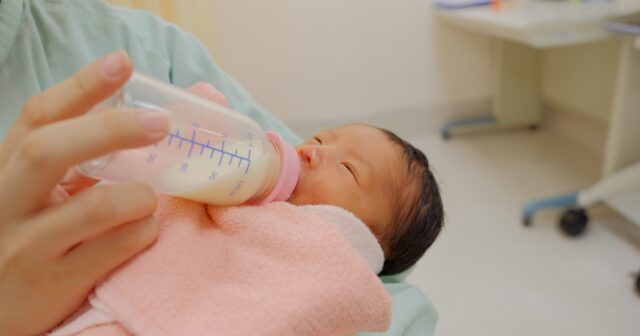
The alleged connection between NEC (Necrotizing Enterocolitis) and baby formula has become a subject of intense scrutiny and legal action. NEC is a severe condition characterized by inflammation and tissue damage in the intestines of newborns.
In recent years, lawsuits have emerged, claiming that certain ingredients in baby formula contribute to the development of NEC in vulnerable infants. Understanding the scientific aspects of NEC and baby formula lawsuits is crucial for unraveling the complex relationship between these factors.
This article delves into the science behind NEC and explores the alleged link to baby formula.
Page Contents
What is NEC?

According to ResearchGate, Necrotizing Enterocolitis (NEC) is a frequently encountered gastrointestinal emergency among newborns. Its occurrence ranges from 4% to 7% in extremely premature infants. NEC is linked to mortality rates of 23% to 51%, neurodevelopmental disabilities of 24% to 61%, and intestinal failure affecting 15% to 35% of cases.
The precise causes of NEC are not fully understood, but multiple factors contribute to its development. Prematurity, an immature immune system, and reduced blood flow to the intestines are significant risk factors.
The disruption of the delicate balance of gut bacteria, known as dysbiosis, also plays a role. Additionally, factors such as formula feeding, infection, and introducing enteral feeds too early are believed to contribute to the development of NEC.
Common NEC baby symptoms include:
- Swelling and abdominal pain and
- Changes in breathing and body temperature
- Changes in blood pressure and heart rate
- Bloody stool and diarrhea
- Yellow or green vomit
- Lethargy
- Lack of weight gain or refusal to eat
Link Between Baby Formula and NEC

The alleged link between baby formula and NEC in infants is a subject of ongoing debate and investigation. Plaintiffs in lawsuits claim that certain ingredients in baby formula contribute to the development of NEC in vulnerable infants.
According to TorHoerman Law, there have been reported occurrences of multiple cases of NEC among infants in the same Neonatal Intensive Care Unit (NICU). It is essential to note that NEC is not contagious in itself. However, the simultaneous presence of NEC in premature babies within the NICU could suggest a potential link to a common factor, such as the use of a particular toxic baby formula or cow milk-based formulas.
Although such cases are infrequent, they could raise concerns regarding the safety or suitability of specific formulas used in a NICU setting.
Research and Studies Linking Baby Formula With NEC
According to AboutLawsuits.com, scientific research has consistently indicated that cow’s milk-based baby formula does not offer the same advantages as breastfeeding and may heighten the likelihood of premature infants developing NEC.
A study conducted in January 2022 revealed that breast milk nutrients aid in the maturation of the intestinal epithelial layer in preterm infants, enhancing their resilience against NEC. However, these essential nutrients are absent in cow’s milk-based infant formulas designed for premature babies, including popular brands such as Similac and Enfamil.
NEC Mechanisms and Pathophysiology

NEC is believed to result from a combination of factors, including an immature immune system, gut bacteria imbalances, compromised barrier function, and reduced blood flow to the intestines. These factors contribute to inflammation, tissue damage, and, in severe cases, necrosis of the intestinal wall.
The presence of specific ingredients in baby formula may exacerbate these processes, potentially increasing the risk of NEC in susceptible infants. Various research on the disease aims to elucidate the intricate mechanisms involved, helping to uncover the underlying causes and potential associations between NEC and baby formula.
Baby Formula Manufacturer’s Liability and Responsibility
Manufacturers must produce safe and reliable products, ensuring that their baby formula meets regulatory guidelines and standards.
According to Forbes Advisor, Abbott Laboratories and Mead Johnson, the manufacturers of Similac and Enfamil baby formulas, respectively, are facing lawsuits from parents of premature infants who were fed these formulas during their hospital stay. These parents allege that the companies failed to provide sufficient warnings to both parents and medical professionals regarding the risks associated with their baby formulas.
The lawsuits claim that Abbott Laboratories and Mead Johnson either knew or should have known about the potential dangers, particularly related to the presence of bovine spongiform encephalopathy (BSE), a component found in cow’s milk that could potentially lead to conditions like NEC, sepsis, failure to thrive, and other hazards for premature infants.
Additionally, the parents argue that the companies neglected to conduct further research into the potential risks associated with their products and failed to adequately warn the public, despite receiving warnings from influential medical organizations.
Ongoing Research and Future Implications

Scientists and medical professionals continue to investigate the potential links, exploring factors such as formula composition, processing methods, and microbial contamination. The findings of these studies could have wide-ranging implications, including the development of improved manufacturing standards, updated regulations, and enhanced product safety measures.
Furthermore, continued research may provide insights into preventive strategies and treatment options for NEC. The ongoing scientific investigations will play a crucial role in shaping the future landscape of baby formula production, regulation, and infant health.
Conclusion
The science behind NEC and its alleged connection to the baby formula is a complex and evolving area of research. While ongoing studies aim to shed light on the potential links, controversies and differing perspectives persist.
As the scientific community continues to explore this topic, it is essential to consider evidence-based findings, engage in open dialogue, and prioritize the well-being of infants. Striking a balance between scientific advancements and regulatory measures will be vital in ensuring the safety and health of our youngest population.































